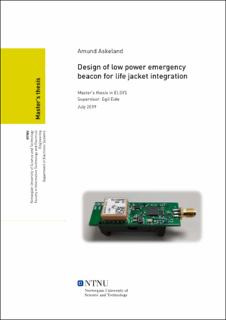| dc.contributor.advisor | Eide, Egil | |
| dc.contributor.advisor | Berntsen, Per Christian | |
| dc.contributor.author | Askeland, Amund | |
| dc.date.accessioned | 2019-10-26T14:04:30Z | |
| dc.date.issued | 2019 | |
| dc.identifier | no.ntnu:inspera:39602101:18094907 | |
| dc.identifier.uri | http://hdl.handle.net/11250/2624688 | |
| dc.description.abstract | Mann over bord (MOB) nødsendarar for bruk med det maritime automatiske idendifikasjonssystemet (AIS) vert i dag av levert av fleire produsentar. Slike nødsendarar fører til auka
sikkerheit for personar som arbeider innanfor maritime neringar, ved at dei bidstår i rask
lokasjon av personar over bord. Eksisterande løysingar er separate einingar som vert festa til
flytevestar, noko som kan føre til plunder og heft i normale arbeidsoppgåver for brukaren. For
å finne ei betre løysing er det ønskeleg å integrere slike nødsendarar i sjølve flytevesten. Dette
arbeidet har som mål og tilrettelegge for slik integrasjon. For å oppnå dette vil utfordringane
ein slik integrasjon fører til bli diskutert, eit forbedra design bli føreslått, og ein prototype vil
bli laga for å kvantisere forbedringar.
Hovedfokuset med dette arbeidet er å redusere størrelsen på AIS MOB nødsendarar, sidan
dette er naudsynt for å få til god integrasjon i flytevestar. Ein stor del av størrelsen i
eksisterande produkt er batteripakkane som vert brukt. Redusert straumforbruk vert derfor
hovedfokuset for å få ned størrelsen på slike produkt.
I dette arbeidet har det blitt utvikla og testa ein fungerande prototype av ein AIS MOB
nødsendar. Prototypen hadde ein signifikant reduksjon i både størrelse og straumforbruk
samanlikna med eksisterande løysingar. Samanlikna med ein AIS MOB nødsendar som nyleg
vart designa i publisert litteratur, har denne prototypen ein tiendedel av straumforbruket. Unøyaktigheitar
i samanlikningane som er gjort, samt behov for vidare arbeid er også diskutert i dette arbeidet. | |
| dc.description.abstract | Man overboard (MOB) devices for use with the automatic identification system (AIS) has
been commercially available for several years. These devices represent an important safety
improvement for personnel working in maritime environments, as they help locate personnel
overboard quickly. Existing solutions are designed as separate devices fastened to a life jacket,
which can represent a hindrance in the work tasks performed by the user. To improve this
design, it is desirable to integrate the device into the life jacket itself. This work aims to
enable such integration by discussing the challenges that this leads to, propose an improved
design, and implement a prototype to quantify the improvements.
The main focus of this work is to reduce the size of AIS MOB devices, as this is key to enable
integration in life jackets. A large contributing factor to the size of existing systems is found
to be the battery packs, and a reduction in power consumption is therefore focused heavily
on in this work.
A fully functional prototype of an AIS MOB beacon is designed and tested. The prototype
showed a significant reduction in both size and power consumption when compared to existing
solutions. Notably, the prototype has less than one tenth of the power consumption of another AIS
MOB beacon design described in recent literature. Limitations with these comparisons and
future work is also identified and discussed. | |
| dc.language | eng | |
| dc.publisher | NTNU | |
| dc.title | Design of low power emergency
beacon for life jacket integration | |
| dc.type | Master thesis | |
